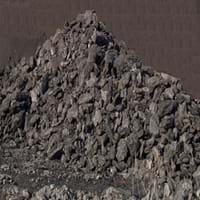Lignite is a soft brownish coal which shows traces of plants and is intermediate between bituminous coal and peat 0
From French, Latin lignum wood + -ite1 0
Durable Rock, Soft Rock 0
Coarse Grained Rock, Fine Grained Rock, Medium Grained Rock, Opaque Rock 0
Black, Brown, Dark Brown, Grey, Light to Dark Grey 0
for Road Aggregate, Steel Production 0
Xyloid Lignite or Fossil Wood and Compact Lignite or Perfect Lignite 0
Generally rough to touch, Helps in production of Heat and Electricity, Used as fossil fuel 0
Archaeological Significance
0
Coal formation takes place due to accumulation of plant debris in a swamp environment. The Coal formation process continues, as peat turns into lignite brown or black coal at increasing heat and pressure. 0
Carbon, Hydrogen, Nitrogen, Oxygen, Sulphur 0
Biological Weathering, Chemical Weathering, Mechanical Weathering 0
Chemical Erosion, Water Erosion, Wind Erosion 0
Medium to Fine Coarse Grained 0
Dull to Vitreous to Submetallic 0
Deposits in Eastern Continents
0
Bangladesh, Burma, Cambodia, China, India, Indonesia, Kazakhstan, Malaysia, Mongolia, Pakistan, Turkey, Vietnam 0
Botswana, Kenya, Morocco, Mozambique, South Africa, Tanzania 0
Belgium, Bulgaria, England, France, Germany, Greece, Hungary, Kosovo, Netherlands, Norway, Poland, Romania, Serbia, Slovakia, Slovenia, The Czech Republic, Ukraine, United Kingdom 0
Deposits in Western Continents
0
Brazil, Chile, Colombia, Venezuela 0
Deposits in Oceania Continent
0
New South Wales, Queensland, Victoria 0
Learn more about Properties of Lignite
What is Lignite? In this section, we will learn more about properties of Lignite i.e. physical and thermal properties. Physical properties of Lignite include Color, Streak, Hardness, Structure, Cleavage, Fracture, Luster, Specific Gravity etc. The strength of Lignite is Not Available. Streak of Lignite is black while its cleavage is non-existent. Luster of Lignite is dull to vitreous to submetallic and its fracture is conchoidal. Lignite is opaque in nature. Know all about Lignite, What is Lignite, its composition, features, facts and reserves in next sections.
Know about Composition of Lignite
What is Lignite composed of? Get to know about composition of Lignite here. Lignite definition gives information about the Formation of Lignite and its composition.The composition of Lignite can be further divided into mineral and compound content. The mineral content of Lignite rock includes Not Available and The compound content of Lignite rock includes Carbon, Hydrogen, Nitrogen, Oxygen, Sulphur. Almost all rocks undergo transformation process. Know all about Lignite rock in next section.









